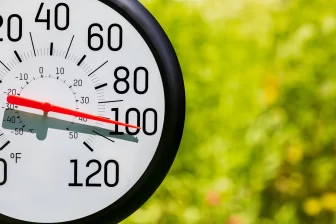By Elinor Epperson

Record-setting heat waves are becoming more frequent due to climate change. Image: JJ Gouin/Adobe Stock
There’s no easy way to say it: The heat is only getting worse.
Extreme heat events in the Great Lakes region will only become more frequent as climate change warms the oceans, lakes and air, a University of Michigan climate expert said. And the earlier that heat waves start each season, the more there may be in the months to come.
Richard Rood is a professor emeritus at the University of Michigan Department of Climate and Space Sciences and Engineering. He said extreme weather will change what feels “normal” for each season.
“What will be normal for the next 20 to 30 years is that things are changing,” he said. “We’re not just taking a step to a new normal.”
Thanks to climate change, unseasonably warm weather is “creeping” into regions where people aren’t used to it.
Heat waves are not just a few hot days, according to a 2017 paper about regional variation in extreme heat. They’re an “anomalous” combination of factors like intensity, duration and frequency of hotter-than-normal days. And they’re getting worse, but what “worse” looks like depends on where you live.
In the Great Lakes region, that means warmer than usual temperatures, day and night. The warmer nights present their own problems.
“We count on cooling off at night, and it will reduce our ability to cool off,” Rood said.
Combined with several days of sweltering heat, this can lead to heat-induced illness. Older adults, children and people with respiratory and heart conditions are the most vulnerable.
Hot days will come more frequently, too.
“What you’re seeing [now] is also a little bit more of a picture into the future,” Rood said. By 2045, most counties in lower Michigan will experience one to two more weeks of extreme heat each summer, according to the National Environmental Public Health Tracking Network at the Centers for Disease Control and Prevention
By 2100, the region can expect 28 to 66 more days over 90 degrees, according to the Great Lakes Integrated Sciences and Assessments, where Rood is a core faculty member.
He said more hot days mean the ground and water will accumulate more heat, increasing the air temperature as the summer progresses.
“This will appear to be a relatively mild or moderate heat wave compared to, say, 10, 20 or 30 years from now,” Rood said.
Elinor Epperson has an environmental reporting internship under the MSU Knight Center for Environmental Journalism’s diversity reporting partnership with the Mott News Collaborative and in cooperation with CNS. This story was produced for Michigan Public.
